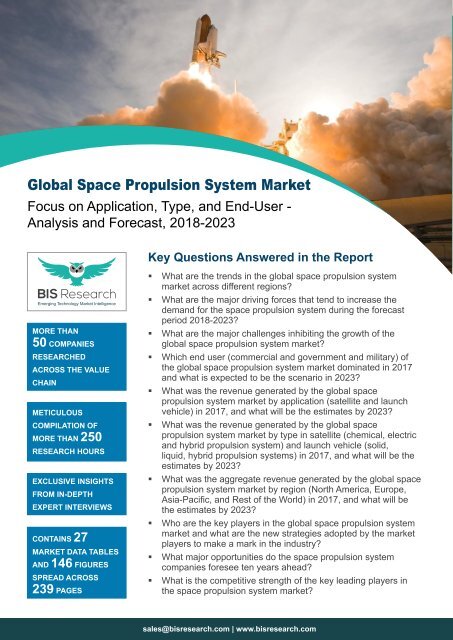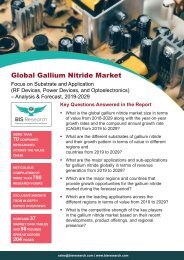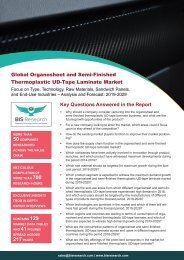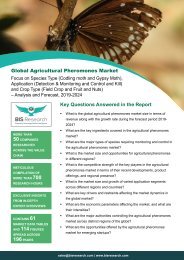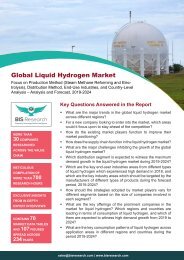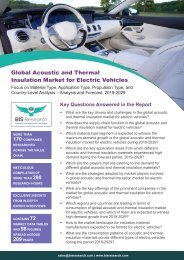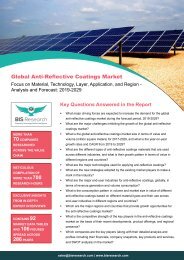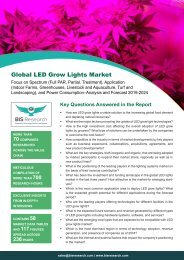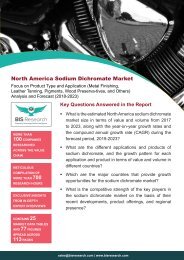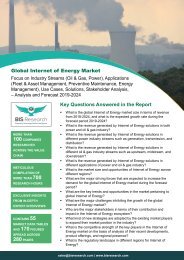Space Propulsion System Market Trends
The introduction of advanced space propulsion systems is anticipated to bring about radical changes in the satellite and launch vehicle manufacturing business. Ongoing efforts by the industry players to develop high end propulsion systems for future applications (example, deep space missions) is expected to boost this industry. Furthermore, given the huge growth in the small satellites and advancement towards reusable launch vehicles, it is expected that the space propulsion system market will observe large number of key strategic developments happening during the forecast period.
The introduction of advanced space propulsion systems is anticipated to bring about radical changes in the satellite and launch vehicle manufacturing business. Ongoing efforts by the industry players to develop high end propulsion systems for future applications (example, deep space missions) is expected to boost this industry. Furthermore, given the huge growth in the small satellites and advancement towards reusable launch vehicles, it is expected that the space propulsion system market will observe large number of key strategic developments happening during the forecast period.
Create successful ePaper yourself
Turn your PDF publications into a flip-book with our unique Google optimized e-Paper software.
Global <strong>Space</strong> <strong>Propulsion</strong> <strong>System</strong> <strong>Market</strong><br />
Focus on Application, Type, and End-User -<br />
Analysis and Forecast, 2018-2023<br />
Key Questions Answered in the Report<br />
MORE THAN<br />
50 COMPANIES<br />
RESEARCHED<br />
ACROSS THE VALUE<br />
CHAIN<br />
METICULOUS<br />
COMPILATION OF<br />
MORE THAN 250<br />
RESEARCH HOURS<br />
EXCLUSIVE INSIGHTS<br />
FROM IN-DEPTH<br />
EXPERT INTERVIEWS<br />
CONTAINS 27<br />
MARKET DATA TABLES<br />
AND 146 FIGURES<br />
SPREAD ACROSS<br />
239 PAGES<br />
• What are the trends in the global space propulsion system<br />
market across different regions?<br />
• What are the major driving forces that tend to increase the<br />
demand for the space propulsion system during the forecast<br />
period 2018-2023?<br />
• What are the major challenges inhibiting the growth of the<br />
global space propulsion system market?<br />
• Which end user (commercial and government and military) of<br />
the global space propulsion system market dominated in 2017<br />
and what is expected to be the scenario in 2023?<br />
• What was the revenue generated by the global space<br />
propulsion system market by application (satellite and launch<br />
vehicle) in 2017, and what will be the estimates by 2023?<br />
• What was the revenue generated by the global space<br />
propulsion system market by type in satellite (chemical, electric<br />
and hybrid propulsion system) and launch vehicle (solid,<br />
liquid, hybrid propulsion systems) in 2017, and what will be the<br />
estimates by 2023?<br />
• What was the aggregate revenue generated by the global space<br />
propulsion system market by region (North America, Europe,<br />
Asia-Pacific, and Rest of the World) in 2017, and what will be<br />
the estimates by 2023?<br />
• Who are the key players in the global space propulsion system<br />
market and what are the new strategies adopted by the market<br />
players to make a mark in the industry?<br />
• What major opportunities do the space propulsion system<br />
companies foresee ten years ahead?<br />
• What is the competitive strength of the key leading players in<br />
the space propulsion system market?<br />
sales@bisresearch.com | www.bisresearch.com
Table of Contents<br />
MARKET DYNAMICS<br />
COMPETITIVE INSIGHTS<br />
INDUSTRY ANALYSIS<br />
GLOBAL SPACE PROPULSION<br />
SYSTEM MARKET, 2018-2023<br />
GLOBAL SPACE PROPULSION<br />
SYSTEM MARKET<br />
(BY APPLICATION)<br />
GLOBAL SPACE PROPULSION<br />
SYSTEM MARKET (BY TYPE)<br />
GLOBAL SPACE PROPULSION<br />
SYSTEM MARKET (BY END USER)<br />
GLOBAL SPACE PROPULSION<br />
SYSTEM MARKET (BY REGION)<br />
FUTURISTIC SCENARIO FOR SPACE<br />
PROPULSION SYSTEM MARKET<br />
• Drivers<br />
• Challenges<br />
• <strong>Market</strong> Opportunities<br />
• Key <strong>Market</strong> Strategies and Developments<br />
• <strong>Market</strong> Share Analysis<br />
• Emerging Start-ups in <strong>Space</strong><br />
<strong>Propulsion</strong> <strong>System</strong> <strong>Market</strong><br />
• Cost Analysis for <strong>Space</strong> <strong>Propulsion</strong><br />
<strong>System</strong><br />
• Patent Analysis<br />
• Supply Chain Analysis<br />
• Industry Attractiveness<br />
• Assumptions and Limitations<br />
• <strong>Market</strong> Overview<br />
• <strong>Market</strong> Overview<br />
• Satellite<br />
• Launch Vehicle<br />
• <strong>Market</strong> Overview<br />
• Satellite<br />
•Chemical <strong>Propulsion</strong> <strong>System</strong><br />
•Electric <strong>Propulsion</strong> <strong>System</strong><br />
•Hybrid <strong>Propulsion</strong> <strong>System</strong><br />
• Launch Vehicle<br />
•Solid <strong>Propulsion</strong> <strong>System</strong><br />
•Liquid <strong>Propulsion</strong> <strong>System</strong><br />
•Hybrid <strong>Propulsion</strong> <strong>System</strong><br />
• <strong>Market</strong> Overview<br />
• Commercial<br />
• Government & Military<br />
• <strong>Market</strong> Overview<br />
• North America<br />
• Europe<br />
• Asia-Pacific<br />
• Rest-of-the-World (RoW)<br />
• Upcoming Technologies in <strong>Space</strong><br />
<strong>Propulsion</strong> <strong>System</strong> <strong>Market</strong><br />
• Business Outlook for Miniaturized<br />
<strong>Propulsion</strong> <strong>System</strong> (Micro <strong>Propulsion</strong><br />
<strong>System</strong>)<br />
• Opportunities around Deep <strong>Space</strong><br />
Mission<br />
COMPANY<br />
PROFILES<br />
• Accion <strong>System</strong>s<br />
• Aerojet Rocketdyne<br />
• Airbus S.A.S<br />
• Ariane Group GmbH<br />
• Blue Origin<br />
• IHI Corporation<br />
• Lockheed Martin<br />
Corporation<br />
• Mitsubishi Heavy<br />
Industries Ltd.<br />
• Moog Inc.<br />
• Northrop Grumman<br />
Corporation<br />
• OHB <strong>System</strong> AG<br />
• Phase Four<br />
• Safran<br />
• <strong>Space</strong> Exploration<br />
Technologies Corp.<br />
(<strong>Space</strong>X)<br />
• Thales Group<br />
GLOBAL SPACE<br />
PROPULSION<br />
SYSTEM MARKET<br />
RESEARCH<br />
METHODOLOGY<br />
• Scope of the Report<br />
• Global <strong>Space</strong> <strong>Propulsion</strong><br />
<strong>System</strong> <strong>Market</strong> Research<br />
Methodology<br />
• Assumptions and<br />
Limitations<br />
APPENDIX<br />
• Related Reports<br />
VIEW COMPLETE TABLE OF CONTENT<br />
sales@bisresearch.com | www.bisresearch.com
List of Tables<br />
1. <strong>Space</strong> <strong>Propulsion</strong> <strong>System</strong> <strong>Market</strong>: <strong>Market</strong> Dynamics<br />
2. Type of Nano Material for <strong>Space</strong> <strong>Propulsion</strong> <strong>System</strong><br />
3. Benefits and Challenges of 3D Printing<br />
4. Some of the Organic and Inorganic Growth Strategies Adopted by the Key Players<br />
5. Emerging Start-ups in <strong>Space</strong> <strong>Propulsion</strong> <strong>System</strong> <strong>Market</strong><br />
6. Patent Analysis: Geosat <strong>Propulsion</strong> <strong>System</strong> Architecture with Electric Apogee Motor<br />
7. Patent Analysis: Rocket-Engine Propellant Delivery <strong>System</strong>s<br />
8. Patent Analysis: Electric Pump Conveying <strong>System</strong> for Solid-Liquid Rocket Engine<br />
9. Patent Analysis: Thermoplastic-Aluminum Nanocomposite Based Hybrid Rocket Fuel Grain<br />
10. Patent Analysis: Maneuvering <strong>System</strong> for Earth Orbiting Satellites with Electric Thrusters<br />
11. Global <strong>Space</strong> <strong>Propulsion</strong> <strong>System</strong> <strong>Market</strong> (by Application), 2017-2023, ($Billion)<br />
12. List of <strong>Propulsion</strong> <strong>System</strong>s and their Advantages and Disadvantages in Satellites<br />
13. Global <strong>Space</strong> <strong>Propulsion</strong> <strong>System</strong> <strong>Market</strong> (by Type), 2017-2023, ($Million)<br />
14. Types and Characteristics of Chemical <strong>Propulsion</strong> <strong>System</strong><br />
15. Types of Cold Gas Thrusters<br />
16. Types and Characteristics of Electric <strong>Propulsion</strong> system<br />
17. Type and Characteristics of Cryogenic and Non-Cryogenic Propellants in Launch Vehicles<br />
18. Advantages of Hybrid <strong>Propulsion</strong> <strong>System</strong> over Solid and Liquid <strong>Propulsion</strong> <strong>System</strong><br />
19. Global <strong>Space</strong> <strong>Propulsion</strong> <strong>System</strong> <strong>Market</strong> (by End User), 2017-2023, ($Billion)<br />
20. List of major GEO Satellite Contracts and Manufacturers<br />
21. Global <strong>Space</strong> <strong>Propulsion</strong> <strong>System</strong> <strong>Market</strong> Size (by Region), $Billion, 2017-2023<br />
22. List of Green <strong>Propulsion</strong> <strong>System</strong>s:<br />
23. Propellants in Green <strong>Propulsion</strong> <strong>System</strong><br />
24. Developments in Reusable <strong>Propulsion</strong> <strong>System</strong>:<br />
25. Expected Launches of Small Satellite Constellations by 2023<br />
26. Details on Deep <strong>Space</strong> Missions since 2010<br />
27. Details of Deep <strong>Space</strong> Missions in 2019 and 2020<br />
sales@bisresearch.com | www.bisresearch.com
Table of Figures<br />
1. Characteristics of the <strong>Space</strong> <strong>Propulsion</strong> <strong>System</strong><br />
2. Global <strong>Space</strong> <strong>Propulsion</strong> <strong>System</strong> <strong>Market</strong> Overview,<br />
2017 and 2023<br />
3. Global <strong>Space</strong> <strong>Propulsion</strong> <strong>System</strong> <strong>Market</strong><br />
(by Application), 2017-2023<br />
4. Global <strong>Space</strong> <strong>Propulsion</strong> <strong>System</strong> <strong>Market</strong><br />
(by End User), 2017-2023<br />
5. Global <strong>Space</strong> <strong>Propulsion</strong> <strong>System</strong> <strong>Market</strong> (by Type),<br />
2017-2023<br />
6. Global <strong>Space</strong> <strong>Propulsion</strong> <strong>System</strong> <strong>Market</strong><br />
(by Region), 2017<br />
7. Number of Satellites Launched from 2010-2018<br />
8. Rocket Launches from 2005 to 2018<br />
9. Stages Involved in Research and Development<br />
Phase of an Engine:<br />
10. Percentage Share of Strategies Adopted by the<br />
<strong>Market</strong> Players, January 2015-October 2018.<br />
Total Developments = 44<br />
11. Partnerships, Agreements, and Contracts Adopted<br />
by Key <strong>Market</strong> Players, 2016-2018<br />
12. Product Launches by the Key <strong>Market</strong> Players,<br />
2016-2018<br />
13. Mergers and Acquisitions Adopted by the Key<br />
<strong>Market</strong> Players, 2017-2018<br />
14. Other Developments by the Key <strong>Market</strong> Players,<br />
2016-2018<br />
15. Global Satellite <strong>Propulsion</strong> <strong>System</strong> <strong>Market</strong>: <strong>Market</strong><br />
Share Analysis, 2017<br />
16. Global Launch Vehicle <strong>Propulsion</strong> <strong>System</strong> <strong>Market</strong>:<br />
<strong>Market</strong> Share Analysis, 2017<br />
17. Cost Analysis for a Satellite <strong>Propulsion</strong> <strong>System</strong><br />
18. Cost Analysis for a Launch Vehicle <strong>Propulsion</strong><br />
<strong>System</strong><br />
19. <strong>Space</strong> <strong>Propulsion</strong> <strong>System</strong>: Supply Chain Analysis<br />
20. <strong>Space</strong> <strong>Propulsion</strong> <strong>System</strong>: Porter’s Five Forces<br />
21. Bargaining Power of Suppliers<br />
22. Bargaining Power of Buyers<br />
23. Threat of New Entrants<br />
24. Intensity of Competitive Rivalry<br />
25. Global <strong>Space</strong> <strong>Propulsion</strong> <strong>System</strong> <strong>Market</strong>,<br />
2017-2023<br />
26. Global <strong>Space</strong> <strong>Propulsion</strong> <strong>System</strong> <strong>Market</strong><br />
(by Application)<br />
27. Global <strong>Space</strong> <strong>Propulsion</strong> <strong>System</strong> <strong>Market</strong><br />
(by Application), 2017-2023, (Volume, Units)<br />
28. Global <strong>Space</strong> <strong>Propulsion</strong> <strong>System</strong> <strong>Market</strong><br />
(by Satellite), 2017-2023<br />
29. Global Satellite <strong>Propulsion</strong> <strong>System</strong> <strong>Market</strong><br />
(by Sub-Category), 2017-2023<br />
30. Global Launch Vehicle <strong>Propulsion</strong> <strong>System</strong> <strong>Market</strong>,<br />
2017-2023<br />
31. Global Launch Vehicle <strong>Propulsion</strong> <strong>System</strong> <strong>Market</strong><br />
(by Subcategory), 2017-2023<br />
32. Global <strong>Space</strong> <strong>Propulsion</strong> <strong>System</strong> <strong>Market</strong> (by Type),<br />
2017-2023<br />
33. Global Satellite <strong>Propulsion</strong> <strong>System</strong> <strong>Market</strong><br />
(by Chemical <strong>Propulsion</strong> <strong>System</strong>), 2017-2023<br />
34. Global Chemical <strong>Propulsion</strong> <strong>System</strong> <strong>Market</strong> (by<br />
Monopropellant Chemical <strong>Propulsion</strong> <strong>System</strong>),<br />
2017-2023<br />
35. Global Chemical <strong>Propulsion</strong> <strong>System</strong> <strong>Market</strong><br />
(by Bipropellant Chemical <strong>Propulsion</strong> <strong>System</strong>),<br />
2017-2023<br />
36. Global Satellite <strong>Propulsion</strong> <strong>System</strong> <strong>Market</strong><br />
(by Electric <strong>Propulsion</strong> <strong>System</strong>), 2017-2023<br />
37. Global Electric <strong>Propulsion</strong> <strong>System</strong> <strong>Market</strong><br />
(by Ion Electric <strong>Propulsion</strong> <strong>System</strong>), 2017-2023<br />
38. Global Electric <strong>Propulsion</strong> <strong>System</strong> <strong>Market</strong> (by Hall<br />
Effect Electric <strong>Propulsion</strong> <strong>System</strong>), 2017-2023<br />
39. Global Electric <strong>Propulsion</strong> <strong>System</strong> <strong>Market</strong> (by<br />
Pulsed Plasma Electric <strong>Propulsion</strong> <strong>System</strong>),<br />
2017-2023<br />
40. Global Electric <strong>Propulsion</strong> <strong>System</strong> <strong>Market</strong> (by Other<br />
Electric <strong>Propulsion</strong> <strong>System</strong>), 2017-2023<br />
41. Global Satellite <strong>Propulsion</strong> <strong>System</strong> <strong>Market</strong><br />
(by Hybrid <strong>Propulsion</strong> <strong>System</strong>), 2017-2023<br />
42. Global Launch Vehicle <strong>Propulsion</strong> <strong>System</strong> <strong>Market</strong><br />
(by Solid <strong>Propulsion</strong> <strong>System</strong>), 2017-2023<br />
43. Global Launch Vehicle <strong>Propulsion</strong> <strong>System</strong> <strong>Market</strong><br />
(by Liquid <strong>Propulsion</strong> <strong>System</strong>), 2017-2023<br />
44. Global Liquid <strong>Propulsion</strong> <strong>System</strong> <strong>Market</strong><br />
(by Subcategory), 2017-2023<br />
45. Global Launch Vehicle <strong>Propulsion</strong> <strong>System</strong> <strong>Market</strong><br />
(by Hybrid <strong>Propulsion</strong> <strong>System</strong>), 2017-2023<br />
46. Global <strong>Space</strong> <strong>Propulsion</strong> <strong>System</strong> <strong>Market</strong> (by End<br />
User), 2017-2023<br />
47. Classification of Global <strong>Space</strong> <strong>Propulsion</strong> <strong>System</strong><br />
<strong>Market</strong> (by End User)<br />
48. Global <strong>Space</strong> <strong>Propulsion</strong> <strong>System</strong> <strong>Market</strong><br />
(by Commercial), 2017-2023<br />
49. Global Commercial <strong>Space</strong> <strong>Propulsion</strong> <strong>System</strong><br />
<strong>Market</strong> (by Application), 2017-2023<br />
50. Global <strong>Space</strong> <strong>Propulsion</strong> <strong>System</strong> <strong>Market</strong> (by<br />
Government & Military End User), 2017-2023<br />
51. Global Government & Military <strong>Space</strong> <strong>Propulsion</strong><br />
<strong>System</strong> <strong>Market</strong> (by Application), 2017-2023<br />
52. Classification of Global <strong>Space</strong> <strong>Propulsion</strong> <strong>System</strong><br />
<strong>Market</strong> (by Region)<br />
53. Global <strong>Space</strong> <strong>Propulsion</strong> <strong>System</strong> <strong>Market</strong><br />
(by Region), 2017 and 2023<br />
sales@bisresearch.com | www.bisresearch.com
Table of Figures<br />
54. North America <strong>Space</strong> <strong>Propulsion</strong> <strong>System</strong> <strong>Market</strong>,<br />
2017-2023<br />
55. North America <strong>Space</strong> <strong>Propulsion</strong> <strong>System</strong> <strong>Market</strong><br />
(by Application), 2017-2023<br />
56. The U.S. <strong>Space</strong> <strong>Propulsion</strong> <strong>System</strong> <strong>Market</strong>,<br />
2017-2023<br />
57. Europe <strong>Space</strong> <strong>Propulsion</strong> <strong>System</strong> <strong>Market</strong>,<br />
2017-2023<br />
58. Europe <strong>Space</strong> <strong>Propulsion</strong> <strong>System</strong> <strong>Market</strong><br />
(by Application), 2017-2023<br />
59. Russia <strong>Space</strong> <strong>Propulsion</strong> <strong>System</strong> <strong>Market</strong>,<br />
2017-2023<br />
60. France <strong>Space</strong> <strong>Propulsion</strong> <strong>System</strong> <strong>Market</strong>,<br />
2017-2023<br />
61. Germany <strong>Space</strong> <strong>Propulsion</strong> <strong>System</strong> <strong>Market</strong>,<br />
2017-2023<br />
62. Italy <strong>Space</strong> <strong>Propulsion</strong> <strong>System</strong> <strong>Market</strong>, 2017-2023<br />
63. Rest-of-Europe <strong>Space</strong> <strong>Propulsion</strong> <strong>System</strong> <strong>Market</strong>,<br />
2017-2023<br />
64. Asia-Pacific <strong>Space</strong> <strong>Propulsion</strong> <strong>System</strong> <strong>Market</strong>,<br />
2017-2023<br />
65. Asia-Pacific <strong>Space</strong> <strong>Propulsion</strong> <strong>System</strong> <strong>Market</strong><br />
(by Application), 2017-2023<br />
66. China <strong>Space</strong> <strong>Propulsion</strong> <strong>System</strong> <strong>Market</strong>,<br />
2017-2023<br />
67. India <strong>Space</strong> <strong>Propulsion</strong> <strong>System</strong> <strong>Market</strong>, 2017-2023<br />
68. Japan <strong>Space</strong> <strong>Propulsion</strong> <strong>System</strong> <strong>Market</strong>,<br />
2017-2023<br />
69. Rest-of-Asia-Pacific <strong>Space</strong> <strong>Propulsion</strong> <strong>System</strong><br />
<strong>Market</strong>, 2017-2023<br />
70. Rest-of-the-World (RoW) <strong>Space</strong> <strong>Propulsion</strong> <strong>System</strong><br />
<strong>Market</strong>, 2017-2023<br />
71. Rest-of-the-World (RoW) <strong>Space</strong> <strong>Propulsion</strong> <strong>System</strong><br />
<strong>Market</strong> (by Application), 2017-2023<br />
72. Leading Factors for Advancement in <strong>Space</strong><br />
<strong>Propulsion</strong> <strong>System</strong><br />
73. <strong>Space</strong> <strong>Propulsion</strong> <strong>System</strong>s and Associated<br />
Technologies<br />
74. Technological Roadmap for <strong>Propulsion</strong> <strong>System</strong>s,<br />
2010-2035<br />
75. <strong>Propulsion</strong> <strong>System</strong> Technology Curve in Satellites<br />
76. Advantages and Disadvantages of ADN and HAN<br />
Technology<br />
77. Advantages and Disadvantages of Water<br />
<strong>Propulsion</strong> Technology<br />
78. Advantages and Disadvantages of Hydrogen<br />
Peroxide Green <strong>Propulsion</strong> Technology<br />
79. Global Small Satellite <strong>Market</strong>, 2017-2023<br />
80. Share of Key Company Profiles<br />
81. Accion <strong>System</strong>s - Product Offerings<br />
82. Accion <strong>System</strong>s - SWOT Analysis<br />
83. Aerojet Rocketdyne - Product Offerings<br />
84. Aerojet Rocketdyne – Overall Financials,<br />
2015-2017<br />
85. Aerojet Rocketdyne – Net Revenue (by Business<br />
Segment), 2015 - 2017<br />
86. Aerojet Rocketdyne - SWOT Analysis<br />
87. Airbus S.A.S - Product Offerings<br />
88. Airbus S.A.S – Overall Financials, 2015-2017<br />
89. Airbus S.A.S – Net Revenue (by Business<br />
Segment), 2015 - 2017<br />
90. Airbus S.A.S – Net Revenue (by Region),<br />
2015-2017<br />
91. Airbus S.A.S - SWOT Analysis<br />
92. Ariane Group GmbH - Product Offerings<br />
93. Ariane Group GmbH - SWOT Analysis<br />
94. Blue Origin - Product Offerings<br />
95. Blue Origin – Engine Propellant<br />
96. Blue Origin - SWOT Analysis<br />
97. IHI Corporation - Product Offerings<br />
98. IHI Corporation – Overall Financials, 2015-2017<br />
99. IHI Corporation – Net Revenue (by Business<br />
Segment), 2015 - 2017<br />
100. IHI Corporation – Net Revenue (by Region),<br />
2015-2017<br />
101. IHI Corporation - SWOT Analysis<br />
102. Lockheed Martin Corporation - Product Offerings<br />
103. Lockheed Martin Corporation – Overall Financials,<br />
2015-2017<br />
104. Lockheed Martin Corporation – Net Revenue<br />
(by Business Segment), 2015 - 2017<br />
105. Lockheed Martin Corporation – Net Revenue<br />
(by Customers), 2015-2017<br />
106. Lockheed Martin Corporation - SWOT Analysis<br />
107. Mitsubishi Heavy Industries Ltd. - Product Offerings<br />
108. Mitsubishi Heavy Industries Ltd. – Overall<br />
Financials, 2015-2017<br />
109. Mitsubishi Heavy Industries Ltd. – Net Revenue<br />
(by Business Segment), 2016 and 2017<br />
110. Mitsubishi Heavy Industries Ltd. – Net Revenue<br />
(by Business Segment), 2015<br />
111. Mitsubishi Heavy Industries Ltd. – Net Revenue<br />
(by Region), 2015-2017<br />
112. Mitsubishi Heavy Industries Ltd. - SWOT Analysis<br />
113. Moog Inc. - Product Offerings<br />
114. Moog Inc. – Overall Financials, 2016-2018<br />
sales@bisresearch.com | www.bisresearch.com
Table of Figures<br />
115. Moog Inc. – Net Revenue (by Business Segment), 2016 - 2018<br />
116. Moog Inc. – Net Revenue (by Region), 2016-2018<br />
117. Moog Inc.- SWOT Analysis<br />
118. Northrop Grumman Corporation - Product Offerings<br />
119. Northrop Grumman Corporation – Overall Financials, 2015-2017<br />
120. Northrop Grumman Corporation – Net Revenue (by Business Segment), 2015 - 2017<br />
121. Northrop Grumman Corporation – Net Revenue (by Region), 2015-2017<br />
122. Northrop Grumman Corporation - SWOT Analysis<br />
123. OHB <strong>System</strong> AG - Product Offerings<br />
124. OHB <strong>System</strong> AG – Overall Financials, 2015-2017<br />
125. OHB <strong>System</strong> AG – Net Revenue (by Business Segment), 2015 - 2017<br />
126. OHB <strong>System</strong> AG – Net Revenue (by Region), 2015-2017<br />
127. OHB <strong>System</strong> AG - SWOT Analysis<br />
128. Phase Four - Product Offerings<br />
129. Phase Four - SWOT Analysis<br />
130. Safran - Product Offerings<br />
131. Safran – Overall Financials, 2015-2017<br />
132. Safran – Net Revenue (by Business Segment), 2015 – 2017<br />
133. Safran – Net Revenue (by Region), 2015-2017<br />
134. Safran - SWOT Analysis<br />
135. <strong>Space</strong>X - Product Offerings<br />
136. <strong>Space</strong>X - SWOT Analysis<br />
137. Thales Group- Product Offerings<br />
138. Thales Group – Overall Financials, 2015-2017<br />
139. Thales Group – Net Revenue (by Business Segment), 2015 - 2017<br />
140. Thales Group – Net Revenue (by Region), 2015-2017<br />
141. Thales Group - SWOT Analysis<br />
142. Global <strong>Space</strong> <strong>Propulsion</strong> <strong>System</strong> <strong>Market</strong> Segmentation<br />
143. Secondary Data Sources<br />
144. Top Down and Bottom Up Approach<br />
145. <strong>Space</strong> <strong>Propulsion</strong> <strong>System</strong> <strong>Market</strong> Influencing Factors<br />
146. Assumptions and Limitations<br />
sales@bisresearch.com | www.bisresearch.com
Research Scope & BIS Methodology<br />
1. Scope of the Report<br />
This report is intended to be a comprehensive study of the global space propulsion system market. The report focuses<br />
largely on providing market information for space propulsion system, covering different segments including end users,<br />
payload range, and region. In addition to this, it focuses on the major driving forces, challenges, and growth opportunities<br />
of the global space propulsion system market. The major players have been identified on the basis of revenue generation<br />
pertaining to the global space propulsion system market, their geographical presence, and company developments<br />
related to space propulsion systems. A detailed company profiling has been done in order to understand the players’<br />
strategic behaviour. The global space propulsion system market has been further explained and analysed on the basis of<br />
regions. Regional landscape has been categorized into four regions, namely: North America, Europe, Asia Pacific, and<br />
Rest of the World. Various forms of regional developments experienced by the space propulsion system manufacturers,<br />
operators, and various governments; are factored based on which the countries’ growth prospects are analyzed.<br />
1.2 Global <strong>Space</strong> <strong>Propulsion</strong> <strong>System</strong> <strong>Market</strong> Research<br />
Methodology<br />
The research methodology design adopted for this specific study includes a mix of data collected from primary and<br />
secondary sources. Both primary sources (in-house experts, industry leaders and market players) and secondary<br />
sources (a host of paid and unpaid databases), along with analytical tools, have been exhaustively used to build the<br />
forecast and predictive models.<br />
Primary Data Sources<br />
The primary sources involve industry experts from the space propulsion system industry, including the suppliers, device<br />
manufacturers, and distributors, among others. Primary resources, such as CEOs, vice presidents, marketing directors,<br />
and technology and innovation directors, among others have been interviewed to obtain and verify both qualitative and<br />
quantitative aspects of this research study.<br />
The research includes interviews with participants throughout the value chain. Besides, online surveys of the participants<br />
were conducted to understand the demand from original equipment manufacturers (OEMs) and other stakeholders in<br />
the market. An extensive questionnaire was shared to get insights from the experts who didn’t participate in discussions.<br />
In some cases, where information was not available, Delphi method was used to arrive at mutual consent with BIS<br />
consultants.<br />
sales@bisresearch.com | www.bisresearch.com
Research Scope & BIS Methodology<br />
Figure 1: Research Methodology<br />
Scope Definition<br />
Research Design<br />
<strong>Market</strong> Study<br />
Qualitative<br />
Quantitative<br />
Primary Interviews/<br />
Secondary Research<br />
Top Down and<br />
Bottom Up<br />
Primary &<br />
Secondary Data<br />
Report<br />
Writing<br />
Data Validation<br />
Data Analysis<br />
Data Collection<br />
The Key Data Points Taken From Primary Sources Include:<br />
• Validation and triangulation of all the numbers and graphs<br />
• Validation of reports segmentation and key qualitative findings<br />
• Understanding the competitive landscape<br />
• Current and proposed production values of a particular product by market players<br />
• Validation of the numbers of the various markets for market type<br />
• Percentage split of individual markets for geographical analysis<br />
sales@bisresearch.com | www.bisresearch.com
Research Scope & BIS Methodology<br />
Secondary Data Sources<br />
The research study involves the usage of extensive secondary sources such as databases, company websites, and<br />
annual reports, among others.<br />
Data Triangulation:<br />
This research study involves the usage of extensive secondary sources, directories, company websites, and annual<br />
reports. It also makes use of the databases such as hoovers, bloomberg, business-week, factiva, and one-source, to<br />
collect useful and effective information for an extensive, technical, market-oriented, and commercial study of the global<br />
space propulsion system market.<br />
The process of market engineering involves the calculation of the market statistics, market size estimation, market<br />
forecast, market crackdown, and data triangulation (the methodology for these quantitative data processes is explained<br />
in the further sections). An extensive primary research study was undertaken to gather the information, and authenticate<br />
the critical numbers derived through segmentation types, industry trends, and the key players in the market.<br />
sales@bisresearch.com | www.bisresearch.com
Research Scope & BIS Methodology<br />
Figure 4: Data Triangulation<br />
The following figure exhibits data triangulation considered:<br />
BIS Research Internal Repository<br />
• Key Players<br />
• Competitive Landscape<br />
• Opportunities/Challenges<br />
• <strong>Market</strong> Size and <strong>Market</strong> Share (2017)<br />
• Influencing Factors<br />
• <strong>Market</strong> Estimates<br />
• Regional Analysis<br />
Bis Research<br />
Internal Repository<br />
Primary Sources<br />
DATA<br />
TRIANGULATION<br />
Secondary Sources<br />
Primary Sources<br />
Secondary Sources<br />
Government and regulatory sources<br />
Publicly available documents by different<br />
government space and research organizations,<br />
such as:<br />
• Federal Aviation Administration (FAA)<br />
• National Aeronautics and <strong>Space</strong><br />
Administration (NASA)<br />
• Indian <strong>Space</strong> Research Organisation (ISRO)<br />
• UK <strong>Space</strong> Agency<br />
• Israel <strong>Space</strong> Agency<br />
• National Oceanic and Atmospheric<br />
Administration (NOAA)<br />
DATABASES<br />
• Bloomberg<br />
• Hoovers<br />
• Factiva<br />
Annual Reports, Presentations, Websites and<br />
Press Release of top players, News Articles,<br />
Journals, and Paid Databases<br />
REQUEST FOR SAMPLE<br />
sales@bisresearch.com | www.bisresearch.com
BIS Research<br />
39111 Paseo Padre PKWY STE 313,<br />
Fremont CA 94538-1686,<br />
Tel: +1-510-404-8135<br />
Global Delivery Centre<br />
Tapasya Corp Heights, Subarea,<br />
Sector 126, Noida, NCR-201303 India<br />
Tel: +91 120 4261540 / +91 120 4261544<br />
To know more about us, please visit our website:<br />
bisresearch.com<br />
For other queries contact:<br />
sales@bisresearch.com<br />
sales@bisresearch.com | | www.bisresearch.com<br />
www.bisresearch.com


